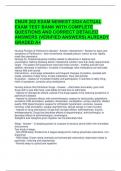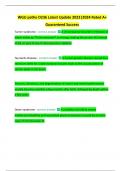CNUR 202 EXAM NEWEST 2024 ACTUAL
EXAM TEST BANK WITH COMPLETE
QUESTIONS AND CORRECT DETAILED
ANSWERS (VERIFIED ANSWERS) ALREADY
GRADED A+
Nursing Process of Parkinson's disease - Answer- Assessment - Assess for signs and
symptoms of Parkinson's - slow movements, stooped posture, tremor at rest, rigidity,
mask like expression.
Nursing Dx- impaired physical mobility related to alterations in balance and
coordination; bathing dressing deficit, imbalanced nutrition: less than body requirements
Goals - The patient will experience improved motor function , mobility and self-care
abilities, decrease in salivation, increase in knowledge, take medications as instructed,
reduce falls and injuries
Interventions - encourage ambulation and frequent changes of position, assisted with
meals, activities of daily living, to take medication, have rest periods
Evaluation - assess for increased mobility and participation in activities of daily living,
relief of symptoms, correctly using medications
Nursing actions Anti-Parkinson Drugs - Answer- - Administer Accurately: give most
drugs with or just after food, read labels for best time to administer
- Assess for therapeutic effects: assess if the drugs appear to be reducing symptoms of
parkinson's disease
- Assess for adverse effects: with anticholinergics: assess for tachycardia, palpitations,
excessive CNS stimulation, sedation, drowsiness, constipation, urinary retention, dilated
pupils. With dopaminergics: assess for orthostatic hypotension, anorexia, nausea,
vomiting, CNS stimulation, cardiac dysrhythmias, abrupt swings in motor function
- Assess for drug interactions: Drugs that increase effects: antihistamines, tricyclic
antidepressants, Drugs that decrease effects of dopaminergics -anticholinergics; or
decrease effects of anticholinergics -cholinergics.
Selegiline and rasagiline given together can be potentially fatal.
Sleep - Answer- - A sleeping person is unaware of sensory stimuli within the immediate
environment
Two kinds of sleep:
- Non-REM sleep: divided into 4 stages designed for resting (physically restorative, non-
dreaming)
- REM sleep: Dream sleep (mentally and emotionally restorative); deprivation leads to
psychosis - learning and experiences
- Normal sleep is cyclical and repetitive
,- About every 90 minutes the sleeper cycles through stages 1-4, followed by 5-20
minutues of REM
Insomnia - Answer- Includes:
- Difficulty falling asleep
- Staying asleep
- Non-restorative sleep
- In combination with daytime dysfunction or distress
- Lack of REM sleep effects a person
Chronic insomnia
- Conditioned insomnia
- Circadian rhythm disorder
Associated with both psychiatric and medical disorders
What is Anxiety? - Answer- - Feelings of apprehension, fear, nervousness, tension, or
worry - can come from not getting a restful sleep
- Is a normal response to a threatening situation and may be beneficial when it
motivates the person toward constructive, problem-solving, coping activities
- Becomes an anxiety disorder when it interferes with day-to-day living, is unrelated to
an actual threat, causes physical symptoms and becomes intolerable to the person
Types of anxiety disorders - Answer- - Generalized anxiety disorder
- Specific phobias
- Social phobia
- Obsessive compulsive disorder
- Post traumatic stress disorder
- Panic disorder
- Also, some people are described as "born worriers." This is referred to as trait anxiety
- personality trait means you are more prone to anxiety disorder
Causes of anxiety disorders - Over sensitive "fight or flight" response - Answer- Over
sensitive "fight or flight" response:
- GABA (gamma-aminobutyric acid) is an anti-anxiety neurotransmitter produced by
glutamate
- When GABA is low the brain's nerve cells can become overactive and transmit signals
more quickly than they should
- Can manifest as nervousness, mental strain, fear, worry and a variety of anxiety
disorders
- Most anxiolytics work in conjunction with GABA to overcome this
Other anxiety disorder causes - Answer- - Combination of biological, psychological and
social factors
- Genetic component
- Physical disease - adrenal tumors may cause anxiety
- Often occurs together with depression and other medical conditions (e.g., cancer, CV
disease)
,- Actions of other drugs - to much stimulants can cause anxiety
CNS depressants - Answer- Sedatives
- Drugs that have an inhibitory effect on the CNS to the degree that they reduce:
- Nervousness
- Mood stabilizing
- Irritability without causing sleeps
Hypnotics
- Calm or soothe the CNS to the point that they cause sleep
- A sedative can become hypnotic if it is given in a large enough dose
Sedative-hypnotics
- Dose dependent
- At low doses, calm or soothe the CNS without inducing sleep (relieves anxiety)
- At high doses, calm or soothe the CNS to the point of causing sleep
Anxiolytics
- Address the underlying neurochemical causes of anxiousness (low GABA)
- Dose dependent
- At high doses, calm or soothe the CNS to the point of causing sleep
- At low doses, help relieve anx
Classes of anxiolytic/sedative-hypnotic agents - Answer- 1. Non-benzodiazepines
a) Buspirone, clomipramine and hydroxyzine as antianxiety agents
b) Chloral hydrate and zolidem as hypnotics
c) Barbiturates
- First introduced in 1903
- Have a narrow therapeutic index
- E.g., butabarbital (Butisol), pentobarbital (Nembutol), phenobarbital (Luminal),
secobarbital (Seconal)
2. Benzodiazepines
a) Introduced in the early 1960's
Nonbenzodiazepines: Barbiturates - mechanism of action and problems with the use of
them - Answer- Mechanism of action: Depress the central nervous system (CNS),
enhance the action of GABA by binding to the GABA-receptor/chloride channel
Four major problems associated with their use:
1. Suppression of REM sleep
2. Induction of drug-metabolizing enzymes in the liver
3. Development of tolerance and cross-tolerance
4. Development of dependence and abuse
Nonbenzodiazepines: Barbiturates - indication of use - Answer- Indication of use:
As hypnotics
- insomnia
As sedatives
- Anesthesia induction (pre surgery)
- Relieve symptoms of anxiety disorder
, - Certain cases of increased intracranial pressure
- Uncontrollable seizures
Benzodiazepines: Indications for use - Answer- Anxiety disorders: Generalized anxiety
disorder, panic, social phobias, performance anxiety, OCD, PTSD
Other conditions where anxiety is a predominant feature: anger, delirium, alcohol
withdrawal (delirium tremens), nicotine abuse, hypochondriasis, eating disorders,
depression
- Sedation
- Sleep induction
- Agitation
- Balanced anesthesia
- Epilepsy
- Acute psychoses
- Skeletal muscle relaxant
Benzodiazepines: Mechanism of Action - Answer- Bind with benzodiazepine receptors
and selective gamma-aminobutyric acid-A (GABA-A) receptors in the brain.
- It enhances response to the inhibitory neurotransmitter GABA, by opening GABA-
activated chloride channels and allowing chloride ions to enter the neuron, making the
neuron negatively charged and resistant to excitation.
- Do not suppress REM sleep as much as barbiturates do
- Do not increase the metabolism of other drugs
- Can lead to tolerance/dependence
- Toxicity -> flumazenil is the antidote
Benzodiazepines: Drug Effects - Answer- - Calming effect on the CNS
- Useful in controlling agitation and anxiety
- Reduce excessive sensory stimulation, inducing sleep
- Induce skeletal muscle relaxation
- Safety
- Efficacy
- Wide margin between therapeutic dose and toxicity
Benzodiazepines: Side Effects - Answer- Mild and infrequent
- Headache
- Drowsiness
- Dizziness
- Vertigo
- Lethargy
- Paradoxical excitement (nervousness)
- "Hangover effect"





